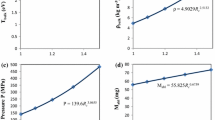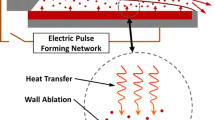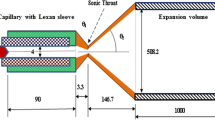Abstract
The 2-D evolution of the plasma as it expands outside the capillary source, which simulates ablation of plasma-facing materials due to high-heat flux deposition, is of importance to investigate the plasma flow scaling laws with inclusion of radial variations. The flow continues from the source exit through a converging–diverging transition region and expands into a large expansion volume that simulates the vacuum chamber of a tokamak fusion reactor. This 2-D modeling resolves the problem of the 1-D steady state analysis of the plasma bulk flow that assumes the flow parameters to vary only in the axial direction with a uniform radial distribution. As the plasma expands towards the sidewalls of the diverging section in the transition region, the bulk plasma has a finite chance to lose energy primarily in the form of heat loss, which might cause readjustment in the profile for plasma bulk temperature giving rise to a decreasing trend in the radial direction. This change in bulk plasma temperature triggers further changes in other bulk flow parameters along the radial directions, away from the axis of the flow. In this work, different mathematical models have been proposed for radial correction in the bulk flow parameter profiles within the system size as a simulation for expansion into the vacuum vessel of a magnetic fusion reactor. Symmetry of the radial profiles over a cross-sectional area has been assumed to facilitate ease of computation and analysis.















Similar content being viewed by others
References
M. Bourham, J. Gilligan, O. Hankins, W. Eddy, J. Hurley, Electrothermal plasma source as a high heat flux simulator for plasma-facing components and launch technology studies, in Proceedings of 9th International Conference on High Power Particle Beams, vol. III, Washington, DC, May 25–29 (1992), pp. 1979–1983
J. Gilligan, M. Bourham, The use of an electrothermal plasma gun to simulate the extremely high heat flux conditions of a tokamak disruption. J. Fusion Energ. 12(3), 311–316 (1993)
E.Y. Shcolnikov, A.V. Chebotarev, Y.A. Kulikov, A.V. Melnik, S.V. Volkov, High efficiency electrothermal accelerator. IEEE Trans. Magn. 31(1), 447–451 (1995)
T. Edamitsu, H. Tahara, Experimental and numerical study of an electrothermal pulsed plasma thruster for small satellites. Vacuum 80(11/12), 1223–1228 (2006)
J.D. Powell, A.E. Zielinski, Capillary discharge in the electrothermal gun. IEEE Trans. Magn. 29(1), 591–595 (1993)
J.D. Hurley, M.A. Bourham, J.G. Gilligan, Numerical simulation and experiment of plasma flow in the electrothermal launcher SIRENS. IEEE Trans. Magn. 31(1), 616–620 (1995)
E. Weiss, D. Zoler, S. Wald, E. Elias, Modeling of electrical confined-capillary-discharge where the discharge zone is extended by an additional pipe. Phys. Lett. A 373(10), 972–975 (2009)
A.L. Winfrey, J.G. Gilligan, A.V. Saveliev, M. AbdAl-Halim, M.A. Bourham, A study of plasma parameters in a capillary discharge with calculations using ideal and non-ideal plasma models for comparison with experiment. IEEE Trans. Plasma Sci. 40(3), 843–852 (2012)
R. Majumdar, J.G. Gilligan, A.L. Winfrey, M.A. Bourham, Supersonic flow patterns from electrothermal plasma source for simulated ablation and aerosol expansion following a fusion disruption. J. Fusion Energ. 33(1), 25–31 (2014)
R. Majumdar, J.G. Gilligan, A.L. Winfrey, M.A. Bourham, Scaling laws of bulk plasma parameters for a 1-D flow through a capillary with extended converging-diverging nozzle for simulated expansion into fusion reactor chamber. J. Fusion Energ. 34(4), 905–910 (2015)
R. Majumdar, M.A. Bourham, Effect of plasma temperature and nonlinearity of the adiabatic compressibility index on flow parameters for hypersonic aerosol expansion following a plasma disruption. J. Fusion Energ. 34(6), 1269–1277 (2015). doi:10.1007/s10894-015-9960-1
John Philip Sharpe, Particulate generation during disruption simulation on the SIRENS high heat flux facility. Ph.D. Dissertation, North Carolina State University, 2000
J.P. Sharpe, B.J. Merrill, D.A. Petti, M.A. Bourham, J.G. Gilligan, Modeling of particulate production in the SIRENS plasma disruption simulator. J. Nucl. Mater. 290, 1128–1133 (2001)
T.J. Dolan (ed.), in Magnetic Fusion Technology, Lecture Notes in Energy 19 (Springer Science and Business Media, 2013), p. 826
Author information
Authors and Affiliations
Corresponding author
Rights and permissions
About this article
Cite this article
Majumdar, R., Bourham, M.A. Radial Profile of Plasma Flow Parameters Following Evolution of Electrothermal Polycarbonate Plasma into a Large Chamber Simulating Impurity Expansion in Fusion Reactor Vacuum Vessel. J Fusion Energ 35, 795–806 (2016). https://doi.org/10.1007/s10894-016-0107-9
Published:
Issue Date:
DOI: https://doi.org/10.1007/s10894-016-0107-9




